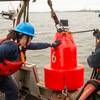For the maritime industry, the advent of the personal computer and related control systems has been a boon. Bridge, propulsion and a host of other onboard controls, formerly a hodgepodge of nonstandard analog and digital systems, now are beginning to benefit from the compactness and standardization of the PC and related control architectures.
"Open" systems (PC industry terminology for a variety of compatibility standards) and the familiar Windows user interface makes PC-based systems relatively easy to integrate, install, maintain and use. From bridge and deck stations to the engine room and the hold, the PC is here to stay.
But between the familiar "pizza box" or "tower" design of commercial PCs and the rugged models that can stand up to the rigors of onboard operation lies a wide gulf. Maritime applications are among the most challenging in the world, far exceeding the rigors of industrial environments. Extremes of temperature, humidity, corrosive salt water, shock and vibration can quickly ruin what otherwise is a highly ruggedized operator interface of sophisticated design.
In maritime applications, the same conditions that make onboard control systems susceptible to failure often come accompanied by difficult operator/user conditions. Specialized keyboards and data entry aids, self-adjusting displays and other human factor-related design considerations are critical when operators must contend with extremes of temperature, vibration and ocean conditions while carrying out complex operating tasks.
On the bridge, where accurate assessment of data and split-second decision making are imperative, the need for display "readability" and system reliability are most apparent. In the tight, "data intensive" environment at the nerve center of any ship, space comes at a premium. In such circumstances, size does count, and the less of it, the better. When "heads up" space is all that's available, tight integration of display (self adjusting hi-brite flat panels work best for a variety of reasons) and computer make real sense.
Further complicating design requirements, radio frequency interference (RFI) generated by communications systems ranging from radar to cell phones can impact or even disable sensitive bridge computers. Design know-how vital to excluding RFI penetration (and its corollary, not creating it) is important, yet is often minimized or overlooked altogether as a specification.
Below decks, the endless pounding created by propulsion systems and waves, when combined with moisture, fumes and airborne contaminants, create more reliability issues for operator interface designers. Electromagnetic interference (EMI) emitted by generators, compressors and pumps, introduces even more reliability problems.
On-deck operator workstations present their own special considerations; PC-based operator interface design solutions are often overlooked altogether because of the enormously punishing environment to which they are subjected. But cargo handling and monitoring, heavy equipment control and other applications can benefit from the graphical display and operator I/O options offered by PC-based systems.
For those who design or use onboard control systems, ruggedness, reliability and ease of use are critical considerations. Azonix Corporation, based in Billerica, Mass., successfully deals with such complexities, designing and building PC-based navigation, bridge control and below deck operator interfaces for a variety of military and civilian clients.
Azonix's market position is supported by two key factors: 1) the company's dedication to designing and manufacturing operator workstations and displays for extreme industrial environments and; 2) modular product design and adaptive engineering services. For clients requiring uniquely adapted systems in quantities of 10s or 100s, the combination of modular design (reliable, upgradeable, long product life) and adaptive engineering (knowledgeable, innovative, application specific) represents real value.
In 1991, after a decade of building high-precision measurement and control systems, Azonix began to develop PC-based computers for extreme environment computing, first making operator workstations for the offshore oil exploration and development marketplace. Happily, oil exploration and maritime application requirements are similar in almost all respects.
ProPanel‚ Azonix's flagship workstation product, was built from the first as an integrated unit combining all the components of a PC in a brazed metal, fully sealed enclosure. At the same time, sealing creates an apparent contradiction to reliable operation: heat build up is the Number One cause of electrical system failure.
Azonix deals with the heat factor by marshaling a variety of innovative design conventions to the task. Flat-panel, LCD computer displays, for instance, allow for large format, high resolution and exceptional brightness (critical for daylight operation), with very low power consumption. Integral radiating fins built into the exterior of ProPanel cases dissipate otherwise destructive heat. Total power requirements one-third or less wattage of the current required by traditional PCs.
To gain a sense of the utility of these unique control devices, four application examples follow:
Bridge Propulsion System Display -- Operates on open decks and bridges
Wide ambient temperature range (any climate/season)
Totally sealed against spray, rain, deck "washover"
Continuing operation, including "rollover" submerged conditions
Viewable in direct sunlight
Lloyd's certified
Oil Exploration Operator Workstation
Operates on offshore oil platforms (any climate/season)
Certified for use in hazardous areas (CENELEC, CSA, etc.)
Isolated against liquids, shock/vibration, EMI/RFI, etc.
Self-adjusting display brightness for 24-hour operation
Networkable, Web ready, easy upgrade/maintainability
Aircraft Carrier Flight Deck Control Operations
Large display/small footprint (Flat-panel LCD) for "heads up"
bulkhead mounting in limited bridge space
Low electronic emissions (EMI/RFI - Mil Spec 461D) - Prevents
interference with communications equipment/detection by enemy
Barge tested (depth charge detonation) for shock resistance
Below Decks Communication System Display
Resistance to extreme shock and vibration from heavy equipment and propulsion systems
Imperviousness to high concentrations of EMI
Sealed system for total resistance to system degradation from washdowns, fumes and airborne contaminants
Noting the variety of hostile influences and number of engineered features that Azonix has built into its maritime operator workstations, it is reasonable to conclude system standards must exceed even the most challenging of those associated with land-based industrial applications. Recognizing this, Azonix has chosen to place its offshore oil exploration, military and maritime experience at the disposal of naval architects, engineers and fleet owners. The ProPanel operator workstation/display, "bred to the ocean" is uniquely suited to a wide variety of maritime applications - perhaps one of them is yours.
Sponsored Content
LR - Fit for 55: Managing compliance and optimising operations

Use Roxtec seals, services and software

Subscribe for
Maritime Reporter E-News
Maritime Reporter E-News is the maritime industry's largest circulation and most authoritative ENews Service, delivered to your Email five times per week









